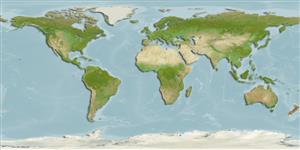>
Gobiesociformes (Clingfishes) >
Gobiesocidae (Clingfishes and singleslits) > Diplocrepinae
Etymology: Diplocrepis: Greek, diploos = twice + Greek, krepis, idos = base, foundation (Ref. 45335).
More on author: Richardson.
Environment: milieu / climate zone / depth range / distribution range
Écologie
marin démersal; profondeur 0 - 15 m (Ref. 9003). Temperate
Southwest Pacific: endemic to New Zealand.
Taille / Poids / Âge
Maturity: Lm ? range ? - ? cm
Max length : 12.5 cm SL mâle / non sexé; (Ref. 9003); common length : 8.5 cm SL mâle / non sexé; (Ref. 9003)
Description synthétique
Morphologie | Morphométrie
Épines dorsales (Total): 0; Rayons mous dorsaux (Total): 10-11; Épines anales 0; Rayons mous anaux: 4 - 5. Olive pink or green to brown, red, yellow or lilac, with or without stripes, spots or bars. Breeding males with pinkish dorsal saddle. Distinguished from other clingfishes by the large, rounded head with incisorform teeth and a large, blunt posteriorly projecting spine at the lower margin of the operculum.
Common in rock pools at low tide and sub-tidally. Found clinging under rocks or boulders in more sheltered areas. Feeds on amphipods, gastropods, and fishes. Takes cover when disturbed.
Life cycle and mating behavior
Maturité | Reproduction | Frai | Œufs | Fécondité | Larves
Eggs are guarded by the male.
Paulin, C. and C. Roberts, 1992. The rockpool fishes of New Zealand (Te ika aaria o Aotearoa). Museum of New Zealand (Te Papa Tongarewa). 177 p. (Ref. 9003)
Statut dans la liste rouge de l'IUCN (Ref. 130435)
Menace pour l'homme
Harmless
Utilisations par l'homme
Plus d'informations
Taille/ÂgeCroissanceLongueur-poidsLongueur-longueurFréquences de longueursMorphométrieMorphologieLarvesDynamique des populations larvairesRecrutementAbondanceBRUVS
RéférencesAquacultureProfil d'aquacultureSouchesGénétiqueElectrophoresesHéritabilitéPathologiesTraitementNutrientsMass conversion
CollaborateursImagesStamps, Coins Misc.SonsCiguateraVitesseType de nageSurface branchialeOtolithesCerveauxVision
Outils
Articles particuliers
Télécharger en XML
Sources Internet
Estimates based on models
Preferred temperature (Ref.
123201): 12 - 16.5, mean 14.8 °C (based on 80 cells).
Phylogenetic diversity index (Ref.
82804): PD
50 = 1.0000 [Uniqueness, from 0.5 = low to 2.0 = high].
Bayesian length-weight: a=0.00468 (0.00180 - 0.01218), b=3.12 (2.90 - 3.34), in cm total length, based on LWR estimates for this (Sub)family-body shape (Ref.
93245).
Niveau trophique (Ref.
69278): 3.7 ±0.63 se; based on food items.
Résilience (Ref.
120179): Milieu, temps minimum de doublement de population : 1,4 à 4,4 années (Fec = 2,500).
Fishing Vulnerability (Ref.
59153): Low vulnerability (10 of 100).
